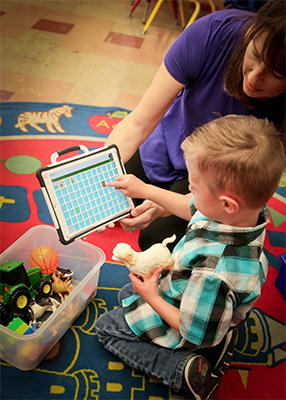Teachers and aids play an important role in teaching language and encouraging communication. During a school day, you spend a lot of hours with a child in an environment rich for learning language, knowledge, and social skills.
- Know the vocabulary available on the child's device.
- Know the locations of words on the device so that you can teach them.
 Teach words by pairing a consistent motor movement with hearing the word and seeing something happen. Don't worry about categories, meanings of symbols, etc. Just show where it is, model its use, and give him a fun and rewarding reason to use it.
Teach words by pairing a consistent motor movement with hearing the word and seeing something happen. Don't worry about categories, meanings of symbols, etc. Just show where it is, model its use, and give him a fun and rewarding reason to use it.
Generalize vocabulary. Teach a word during different activities so that the child fully understands the meaning.
Accept all forms of communication: gestures, facial expressions, intelligible verbalizations. If you understand what the child is saying, don't make him "say it on your device."
Give the AAC communicator a chance to communicate for a variety of reasons, not just labeling and requesting (greeting, rejection, commenting, directing, describing, etc.).
Don't expect the child to answer in full sentences; accept telegraphic utterances and interpret them in context. Consider natural language development and where the individual child is on that continuum.
Modify teaching activities based on the individual child's sensory needs and language skills.
- A child with poor receptive language skills and/or poor sensory modulation will need a lot of one-on-one teaching. Teaching opportunities should be multi-sensory to address sensory needs and teach meanings of words in context.
- The more receptive language skills gained, the more the child will be able to do more traditional teaching tasks. These should be added slowly as the child's ability to sit, attend, engage, and understand increases.
Teach concepts before you test them: Kids with language delays have difficulty learning concepts by being told what they mean. They need to see it and experience it! Initially, give them an opportunity to use words and see a response without a right or wrong answer. Ask open ended questions. Examples are listed below.
- Days of the week: Let them say any day, then the teacher or class sings a song about that day.
- Kid can say a feeling and other kids have to act out that feeling.
- Teach names of other students by having all the kids hide and then pop out when their name is said on the device.
- During circle time, let them choose whatever they want to say about themselves. Once they say it, the teacher could say, "That's right, you live in Memphis," and show them a picture of their home or "That's right! Your name is Joe," and show a picture of the child.
- The child could practice "go" and "stop" to start and stop music, get the other kids to start and stop when walking down the hall, to tell the other kids when to start and stop dancing, etc.
- Literacy Activities: When writing stories, ask the child what he wants the story to be about. After reading a page/story, ask the child to tell you a word about the story.
Frame activities and questions so that child can answer with the available vocabulary. When adding words to the system, consider if it’s something the child is passionate about or will benefit him across settings and throughout his life. Do not temporarily add words for a particular lesson. Consider other ways to test knowledge of lesson specific concepts that are not communicated frequently. For example, instead of storing Paul Revere, ask “tell me about Paul Revere?”
